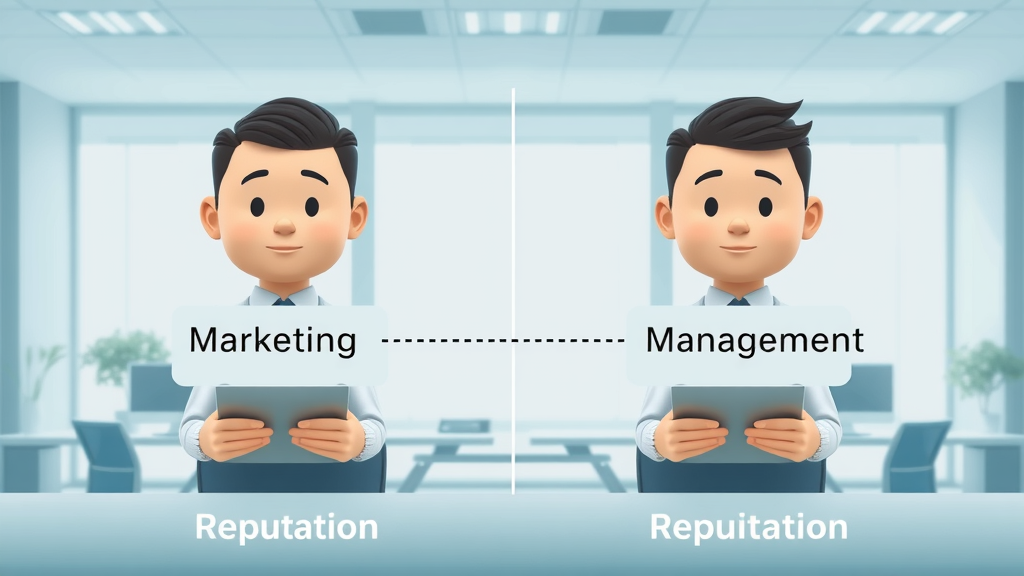Did you know? Over 90% of consumers read online reviews before visiting a business, and a single negative review can cost you up to 22% of potential customers. Reputation marketing strategies are no longer optional—they’re essential tools that shape your business’s success and public perception in the digital age. In this comprehensive guide, you’ll uncover why these strategies make or break brand reputation, which tools actually work, and how leading businesses turn customer feedback into competitive growth.
Opening Insights on Reputation Marketing Strategies
According to a recent study, 84% of people trust online reviews as much as personal recommendations, and a strong brand reputation can increase revenue by up to 20%. These numbers underscore an undeniable truth: effective reputation marketing strategies directly fuel a brand’s ability to attract, retain, and build trust with customers in the digital landscape.

Why Reputation Marketing Strategies Are Critical in Today’s Digital Landscape
- Brand reputation can shift dramatically within hours due to viral social media or review sites posts.
- Studies show that 79% of consumers trust online reviews as much as recommendations from friends and family (social proof).
- Consumer trust metrics reveal that businesses with a positive reputation see higher customer loyalty and conversion rates.
In a world where your online presence is instantly accessible, the voice of each customer—positive or negative—has unprecedented power. Reputation marketing strategies allow businesses not only to manage their reputation but also to actively cultivate a positive reputation. This not only attracts potential customers but also helps retain existing ones, building long-term brand value. Whether a small business or a market leader, investing in reputation marketing efforts secures trust, credibility, and lasting success.
As you explore the core elements of reputation marketing, it’s worth noting that even small, actionable changes can yield immediate results. For those seeking quick wins, consider reviewing these reputation marketing hacks that boost sales instantly—they offer practical tips to enhance your brand’s credibility and drive conversions right away.
What You’ll Learn About Reputation Marketing Strategies
- The fundamentals of reputation marketing
- The best reputation marketing strategies for 2024
- How to leverage customer reviews and feedback
- Protecting and enhancing brand reputation
- Tools to streamline reputation marketing efforts

Understanding Reputation Marketing Strategies
Defining Reputation Marketing and Its Difference from Reputation Management
"Your brand is what people say about you when you're not in the room." – Jeff Bezos
Reputation marketing strategies involve proactively promoting and amplifying positive brand experiences to influence how potential customers and the market at large perceive a business. In contrast, reputation management is more about monitoring and addressing brand perception, often reacting to negative events or feedback. While both focus on your brand reputation, reputation marketing puts the spotlight on proactive marketing efforts—leveraging customer reviews, testimonials, and positive brand content to build trust and differentiated value within your industry.

The Evolution of Brand Reputation in the Digital Age
- In the past, brand reputation relied heavily on word of mouth, print media, and direct customer experiences.
- The digital age ushered in review sites and social media, rapidly amplifying both praise and criticism.
- Now, businesses must adapt their reputation marketing strategies to include real-time engagement and data-driven adjustments—ensuring their online presence accurately reflects brand values and fosters a positive reputation.

Core Elements of Effective Reputation Marketing Strategies
Integrating Reputation Marketing and Reputation Management

For a truly resilient brand reputation, modern organizations must blend proactive reputation marketing with vigilant reputation management. This means amplifying positive brand stories while simultaneously monitoring, responding, and learning from all feedback. Successful reputation marketing strategies coordinate both sides—leveraging reputation management software to track mentions and reviews, then using those insights to inform authentic marketing efforts that showcase your brand’s unique strengths.
Integration is no longer optional—search engines, social media, and review sites often rank businesses, in part, on their engagement with customer feedback and how quickly they resolve issues. Smart companies build a workflow that anticipates reputation risks, highlights customer success stories, and ensures every touchpoint reinforces a positive reputation for both new and loyal customers.
Customer Reviews and Online Feedback: The Bedrock of Trust
Customer reviews and feedback form the foundation of effective reputation marketing strategies. Research shows that customers are 12 times more likely to trust user-generated content, like online reviews, over traditional marketing materials. Positive reviews validate your business in the eyes of potential customers, while genuine responses to customer feedback demonstrate accountability and customer care, enhancing brand reputation.
Building robust routines for collecting, showcasing, and responding to both positive and negative reviews drives trust and increases your brand’s influence in the market. Monitoring review sites and encouraging happy customers to leave feedback on social media are essential steps in reputation marketing that directly impact revenue, search rankings, and long-term customer loyalty.
Building a Positive Online Reputation Through Authentic Engagement
Authentic engagement—the real-time interaction between your brand and your audience on digital channels—defines modern reputation marketing strategies. By engaging customers on social media, responding thoughtfully to both praise and complaints, and sharing behind-the-scenes content, brands can humanize themselves, creating genuine connections that fuel a positive reputation.
Consistency is key. Brands that routinely interact, share user-generated content, and participate in online discussions build relationships with both potential and existing customers. This increases customer loyalty, reinforces positive perceptions, and ensures your business remains top of mind when purchase decisions arise—turning online presence into a tangible asset.
Online Review Response Best Practices and Amplifying Positive Brand Content
- Prompt response to reviews: Quick, polite replies to customer reviews show you value feedback and care about customer experience.
- Encouraging positive reviews: Ask satisfied customers to leave feedback on major review sites and social media.
- Handling negative feedback: Address concerns transparently, offer solutions, and always remain professional—turn a negative review into a positive brand story.
- Showcasing positive brand content: Feature glowing reviews, testimonials, awards, and user stories across all marketing channels to amplify positive sentiment.
Developing a Winning Reputation Marketing Strategy
Identifying Marketing Strategy Goals for Brand Reputation

To maximize the benefits of your reputation marketing strategy, you must first clarify your brand reputation goals. Are you aiming to improve overall ratings, become a top search result on review sites, or reduce negative feedback exchange rates? Aligning your team around clear objectives—such as enhancing source credibility, increasing positive reviews, or establishing thought leadership—will help guide the tactics and daily actions that power long-term marketing efforts.
Celebrate small achievements, adjust your tactics based on real-world data, and communicate goals across the organization. This ensures every department, from sales to customer service, remains focused on supporting and protecting your brand reputation.
Mapping Your Online Presence and Reputation Marketing Efforts
Your online presence forms the public face of your company across social media, business directories, review sites, and other digital platforms. Creating a clear map of where your brand is mentioned—both positively and negatively—enables you to target reputation marketing efforts efficiently. Analyze which platforms bring the most visibility, where potential customers are most active, and which sources yield the strongest brand reputation signals.
Use regular audits to flag inconsistencies, outdated content, or negative feedback. By understanding the digital terrain, your team can deploy resources and create content that amplifies strengths and swiftly addresses weaknesses—transforming challenges into opportunities for positive engagement.
Leveraging Reputation Marketing Software and Tools
Advanced reputation marketing software streamlines review monitoring, automates response workflows, and provides actionable analytics. Modern tools like Birdeye, Podium, Reputation.com, and Trustpilot allow brands to aggregate and respond to customer reviews across all major review sites from one dashboard. This automation ensures that marketing teams stay proactive, turning feedback into reputation-building opportunities while saving time and minimizing human error.
Choosing the right software means considering features (multi-platform review monitoring, real-time alerts, reporting tools, integration with CRMs), pricing, and scalability. Investing in smart automation frees up your team to focus on strategic, high-impact marketing activities that drive growth and support a positive reputation.
| Software | Main Features | Pricing | Integrations |
|---|---|---|---|
| Birdeye | Review aggregation, real-time notifications, reporting, social listening | From $299/month | CRM, Google, Facebook, SMS |
| Podium | Customer messaging, automated review invites, analytics | From $289/month | POS, Google, Apple, SMS |
| Reputation.com | Multi-location monitoring, surveys, business listings management | Custom Pricing | CRM, Marketing Automation, Facebook |
| Trustpilot | Review collection, widgets, SEO tools, reporting | Free & Paid Plans | Shopify, WooCommerce, Google |
Content Creation for Reputation Marketing Strategies
Crafting Brand Content That Amplifies Positive Perception

Content lies at the heart of reputation marketing strategies. Creating engaging, informative, and authentic brand content—from blog posts and videos to customer success stories—shapes public perception and enhances your brand’s credibility. Incorporate customer reviews, positive stories, and data points that reflect your values, expertise, and dedication to customer satisfaction.
For maximum impact, feature positive brand content prominently on your website, share it via email marketing, and strategically post on social media and third-party review sites. High-quality visuals, video testimonials, and clear calls to action further reinforce a positive reputation and encourage further engagement.
Amplifying Positive Brand Content Across Channels
Amplifying positive brand content means distributing your message on platforms where potential and current customers are most active. This multidimensional approach keeps your brand reputation front and center, driving engagement and trust. Content syndication, influencer partnerships, and sponsored posts can help reach new audiences and reinforce your brand’s message across digital touchpoints.
- Social media platforms: Facebook, Instagram, LinkedIn, Twitter
- Your business website and blog
- Third-party review sites like Google, Yelp, Trustpilot
- Email marketing campaigns targeting existing customers
Consistent, strategic distribution of positive brand content cements a favorable perception and rewards advocacy, prompting more users to share their own positive experiences with your brand.
Handling Negative Feedback in Reputation Marketing Strategies
Turning Negative Feedback Into Positive Brand Outcomes

Negative reviews and feedback, while daunting, present unique opportunities to showcase transparency, responsiveness, and a commitment to improvement. Smart brands use reputation marketing strategies not to hide from criticism, but to confront it head-on—responding quickly, empathizing with the customer, and publicly demonstrating solutions. This turns potentially damaging experiences into powerful stories of customer care.
Brands that handle criticism with empathy and action often see improved online reputation, increased customer loyalty, and even a surge in positive reviews as a result. The key is to remain proactive: anticipate concerns, empower frontline teams, and turn every complaint into a showcase for your values and dedication.
Strategies for Crisis Management and Damage Control
- Immediate response: Address negative situations with urgency, showing you’re aware and taking action.
- Public vs. private resolution: Some issues need transparent public responses, while others are best handled privately—know the difference.
- Learning from negative feedback: Use feedback for continuous improvement, updating practices, and preventing future crises.
Employing a clear escalation protocol, monitoring for emerging issues using marketing software, and maintaining honest communication builds resilience during tough times. Effective crisis management not only protects brand reputation—it can ultimately enhance your image as a responsive, ethical business leader.
Maximizing Reputation Marketing Efforts for Sustainable Success
Continuous Monitoring and Adapting Reputation Marketing Strategies

Sustaining a positive reputation means adopting a cycle of “listen, learn, act.” Continuously monitor digital channels, analyze sentiment shifts, and adapt your reputation marketing strategies as trends, platforms, and consumer habits evolve. Powerful marketing software can alert you to spikes in either positive or negative feedback and help you spot emerging themes that warrant attention or celebration.
Analysis isn’t just for crisis avoidance; it’s a source of strategic insight, helping inform content creation, campaign planning, and resource allocation. The brands that succeed in today’s landscape are those embracing change, measuring results, and regularly refreshing their approach to maintain trust and relevance.
Measuring the Impact of Your Reputation Marketing Strategy
If you can’t measure it, you can’t improve it. The most successful reputation marketing strategies use metrics and KPIs to gauge impact and guide future investment. Key indicators include review volume, average rating, customer sentiment scores, resolution rates, share of voice on social media, and referral traffic from review sites. Tracking these KPIs provides a clear picture of the health and direction of your brand reputation.
| KPI | Description | How to Measure |
|---|---|---|
| Review Volume | Total number of new reviews across all channels | Reputation dashboard analytics |
| Average Rating | Mean star rating from review sites and social media | Aggregate from all profiles |
| Response Rate | Percentage of reviews receiving replies | Automated response tracking in software |
| Sentiment Score | AI or manual analysis of positive/negative feedback ratio | Sentiment analysis tools |
| Referral Traffic | Clicks from review sites to your website | Google Analytics/Utm parameters |
"Reputation is an asset, not just a perception. Invest in it wisely." – Industry Expert
Reputation Marketing Strategies: Industry Leader Examples
Case Study: Building Brand Reputation Through Customer Reviews
Consider a major online retailer that implemented a review collection program, incentivizing customers to share experiences. Within six months, their average rating rose by a full star, and organic search traffic increased by 25% as search engines rewarded their enhanced online reputation. This proactive approach turned happy customers into brand ambassadors, with real reviews leading to improved trust and conversion rates.
The campaign was supported by automated reputation marketing software that sent review requests, tracked feedback trends, and notified staff of urgent responses. By showcasing top feedback on social media and the company blog, the brand kept a steady influx of positive reviews across multiple platforms.
Case Study: Online Reputation Management in a Crisis
A global hospitality chain faced a wave of negative reviews after a viral social media incident. Instead of deleting or ignoring the feedback, the company moved quickly—publicly acknowledging the issue, apologizing, and detailing improvements. Their transparent, authentic responses transformed the crisis into a lesson in brand accountability. In the months that followed, the chain’s booking rates recovered, and sentiment scores actually improved as old and new guests praised their honest approach to crisis management.
This example highlights how paired reputation marketing and reputation management—together with timely, strategic communication—protect brand reputation and build long-term resilience.

People Also Ask
What is reputation marketing?
Reputation marketing involves using various strategies and tools to influence how a brand or business is perceived online by highlighting positive experiences, leveraging customer reviews, and building a trustworthy presence across digital channels.
What are the 4 marketing strategies?
The four primary marketing strategies are product, price, place, and promotion. These strategies help brands reach their target market and build a solid brand reputation.
What are the 4 targeting strategies in marketing?
The four targeting strategies include undifferentiated (mass) marketing, differentiated (segmented) marketing, concentrated (niche) marketing, and micromarketing (local or individual marketing). Each can be tailored to enhance reputation marketing strategies.
What are 5 strategies you would use to ensure that your online reputation was protected?
1. Regular monitoring of online reviews and social media
2. Proactive collection of positive reviews
3. Immediate and constructive responses to negative feedback
4. Publishing authentic brand content
5. Implementation of reputation management software
Key Takeaways for Modern Reputation Marketing Strategies
- The integration of reputation marketing and reputation management is essential
- Positive online reviews fuel a successful brand reputation
- Dedicated strategies and software tools help monitor and amplify reputation marketing efforts
- Regular adaptation is crucial for long-term brand success
Frequently Asked Questions: Reputation Marketing Strategies
- How do reputation marketing strategies benefit small businesses?
- What is the difference between reputation marketing and online reputation management?
- What are the main challenges in reputation marketing?
- How do I choose the right reputation marketing software?
Conclusion: Power Your Brand with Effective Reputation Marketing Strategies
Harnessing top reputation marketing strategies allows brands to take control of their online presence, foster a positive reputation, and drive tangible business growth. For more comprehensive guidance, read The Ultimate Guide to Online Reputation Management: Strategies, Tools, and Best Practices.
If you’re ready to elevate your approach and unlock even more advanced strategies, there’s a wealth of insight waiting for you. Explore how reputation marketing fits into a broader digital reputation management framework, discover the latest tools, and learn how industry leaders future-proof their brands. For a deeper dive into holistic strategies and expert best practices, don’t miss The Ultimate Guide to Online Reputation Management: Strategies, Tools, and Best Practices. This resource will help you connect the dots between tactical wins and long-term brand resilience, ensuring your reputation remains a powerful asset in any market climate.

Next Steps: Get Expert Help with Reputation Marketing Strategies
Need Help? Call Digital Media Marketing at 1-586-997-0001 for professional support in implementing world-class reputation marketing strategies.
 Add Row
Add Row  Add
Add 




Write A Comment